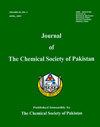紫锥菊生物合成纳米银的研究纳特。及其抗氧化活性
IF 0.5
4区 化学
Q4 CHEMISTRY, MULTIDISCIPLINARY
Journal of the chemical society of pakistan
Pub Date : 2022-01-01
DOI:10.52568/001187/jcsp/44.06.2022
引用次数: 2
摘要
本研究以紫锥菊为原料合成银纳米粒子(Ep-AgNPs)。纳特。收集苍白树干叶,在55℃和176℃的去离子水中加热,过滤后用AgNO3处理,得到Ep-AgNPs。采用紫外可见(UV-Vis)、傅里叶变换红外(FTIR)、x射线衍射(XRD)和扫描电子显微镜(SEM)对Ep-AgNPs进行了分析。特征羟基在3147 cm-1处出现峰。紫外-可见光谱分析中,在468 nm处观察到的吸收带证明了Ep-AgNPs的合成成功。SEM分析表明,纳米结构呈球形,平均尺寸为77.82 nm。XRD分析揭示了Ep-AgNPs的面心晶体结构。采用1,1-二苯基-2-吡啶-肼基自由基(DPPH•)清除率、铁还原抗氧化能力(FRAP)、2,2和#39;-氮基-双(3-乙基苯并噻唑-6-磺酸)自由基阳离子(ABTS•+)测定法进行抗氧化研究,结果表明Ep-AgNPs具有良好的抗氧化作用。与标准BHT (10.78, IC50, #181;g/ml)相比,Ep-AgNPs显示出出色的DPPH•活性(6.34,IC50, #181;g/ml)。在ABTS•+和降低功率试验中也观察到高活性。因此,Ep-AgNPs可能是食品和制药工业的一种有价值的材料。本文章由计算机程序翻译,如有差异,请以英文原文为准。
Biosynthesis of Silver Nanoparticles using Echinacea pallida (Nutt.) Nutt. and Antioxidant Activity Thereof
In this work, silver nanoparticles (Ep-AgNPs) were synthesised using Echinacea pallida (Nutt.) Nutt. The dried leaves of E. pallida were collected and heated at 55 and#176;C in deionized water, and filtered, and the leaf extract was treated with AgNO3 to produce the Ep-AgNPs. The Ep-AgNPs were analyzed by Ultraviolet-visible (UV-Vis), Fourier transform infrared (FTIR), X-ray diffraction (XRD), and scanning electron microscope (SEM). The characteristic hydroxyl gave the peak at 3147 cm-1. In UV-Vis analysis, observation of absorption band at 468 nm proved the achievement of Ep-AgNPs synthesis. SEM analysis presented the spherical shape of nanostructures with an average size of 77.82 nm. The face-centered crystal structure of Ep-AgNPs was revealed by the XRD analysis. The 1,1-diphenyl-2-picryl-hydrazyl radical (DPPH•) scavenging, ferric reducing antioxidant power (FRAP), 2,2and#39;-azino-bis(3-ethylbenzothiazoline-6-sulphonic acid) radical cation (ABTS•+) assays were employed for antioxidant study in which Ep-AgNPs exhibited excellent antioxidant effect. Ep-AgNPs displayed outstanding DPPH• activity (6.34, IC50, and#181;g/ml) compared to the standard BHT (10.78, IC50, and#181;g/ml). The high activity was observed for ABTS•+ and reducing power assays as well. Hence, Ep-AgNPs could be a valuable material for the food and pharmaceutical industry.
求助全文
通过发布文献求助,成功后即可免费获取论文全文。
去求助
来源期刊
CiteScore
1.30
自引率
14.30%
发文量
41
审稿时长
3.4 months
期刊介绍:
This journal covers different research areas in the field of Chemistry. These include; Analytical Chemistry, Applied Chemistry, Biochemistry, Environmental Chemistry, Industrial Chemistry, Inorganic Chemistry, Organic Chemistry and Physical Chemistry. The journal publishes full length articles and Reviews from researchers in academia in addition to featuring comments. Chemical Research presents short, concise and critical articles offering easy-to-read overviews of basic research and applications in all areas of chemistry.

 求助内容:
求助内容: 应助结果提醒方式:
应助结果提醒方式:


